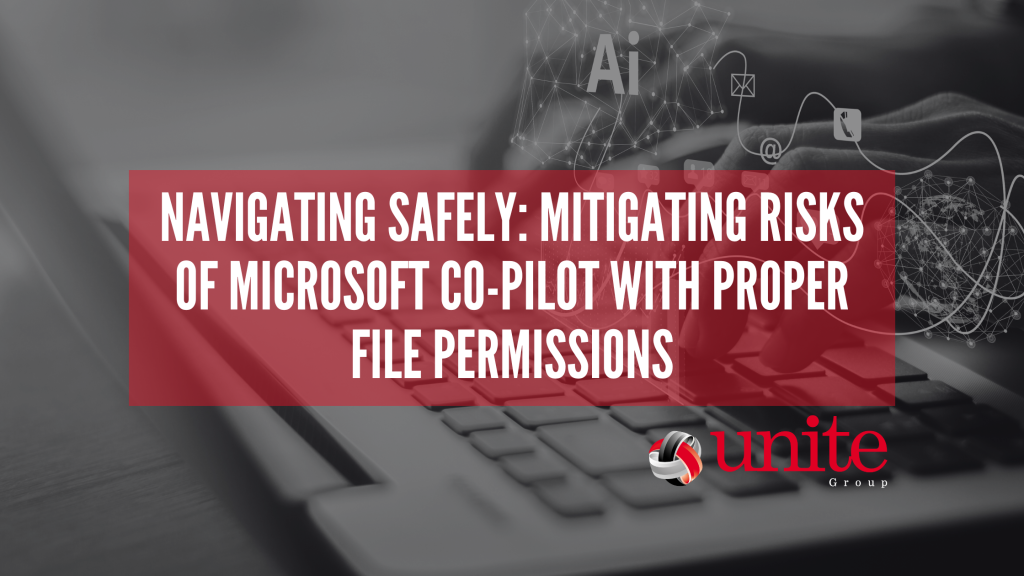
As Microsoft Co-Pilot continues to revolutionise human-computer interaction, it introduces a new frontier of possibilities and efficiencies. However, like any powerful tool, it comes with its set of risks, particularly concerning file permissions. Without ensuring that your files have the correct permissions, the convenience and innovation brought by Co-Pilot can potentially lead to unintended consequences.
In this blog, we’ll delve into the risks associated with Microsoft Co-Pilot when file permissions are overlooked and explore strategies to mitigate these risks.
1. Unauthorised Access and Data Exposure:
One of the primary risks of neglecting file permissions in the context of Microsoft Co-Pilot is the potential for unauthorised access to sensitive data. Co-Pilot’s powerful capabilities, if misused or misunderstood, may lead to unintended exposure of confidential information. Without proper file permissions, there’s a risk that Co-Pilot could inadvertently share files or data with individuals who should not have access.
2. Data Integrity Concerns:
In a collaborative digital environment, maintaining the integrity of data is paramount. Incorrect file permissions may result in unintended modifications or deletions of files, compromising the accuracy and completeness of critical data. Ensuring the right individuals have the appropriate permissions is essential to prevent accidental or malicious alterations.
3. Compliance and Regulatory Issues:
Various industries are subject to stringent data protection regulations and compliance standards. Neglecting file permissions in the use of Microsoft Co-Pilot can lead to non-compliance, potentially resulting in legal consequences, fines, and damage to an organisation’s reputation. It’s crucial to align Co-Pilot usage with established data protection guidelines and industry-specific regulations.
4. Risk of Insider Threats:
While Microsoft Co-Pilot enhances productivity and collaboration, the absence of correct file permissions poses a risk of insider threats. Employees, whether intentionally or unintentionally, might misuse Co-Pilot, leading to data breaches, leaks, or compromise of sensitive information. Proper file permissions act as a critical control mechanism against insider threats.
5. Loss of Intellectual Property:
For organisations that heavily rely on proprietary information and intellectual property, the risk of unauthorised access through Co-Pilot is a significant concern. Without meticulous attention to file permissions, there’s a potential for valuable intellectual assets to be accessed, shared, or modified without appropriate authorisation.
Mitigating Risks: Strategies for Ensuring Correct File Permissions with Microsoft Co-Pilot
Education and Training:
Implement comprehensive training programs to educate employees about the proper use of Microsoft Co-Pilot and the importance of adhering to file permissions. Ensure that they understand the potential risks associated with misconfigured permissions and the impact on data security and compliance.
Regular Audits and Monitoring:
Establish a regular audit schedule to monitor file permissions within your digital ecosystem. Conducting periodic reviews allows organisations to identify and rectify any discrepancies promptly. Automated monitoring tools can assist in real-time tracking of file permission changes.
Implement Role-Based Access Controls (RBAC):
Adopt a role-based access control system that aligns with the organisation’s hierarchy and job responsibilities. By assigning permissions based on job roles, you reduce the likelihood of unnecessary access to sensitive data and minimise the risk of inadvertent file modifications.
Utilise Encryption Technologies:
In addition to proper file permissions, leverage encryption technologies to add an extra layer of security. Encrypting sensitive files ensures that even if unauthorised access occurs, the data remains protected and unreadable without the appropriate decryption keys.
Regularly Update and Patch Systems:
Keep Microsoft Co-Pilot and associated systems up to date with the latest security patches and updates. Regular updates often include security enhancements and fixes, reducing the risk of vulnerabilities that could be exploited to manipulate file permissions.
Implement Access Review Processes:
Establish regular access review processes to reevaluate and adjust file permissions as needed. As organisational structures change, keeping permissions aligned with job roles and responsibilities becomes crucial for maintaining a secure digital environment.
Conclusion: Navigating Safely in the Co-Pilot Era
Microsoft Co-Pilot holds immense potential to redefine human-computer interaction and boost productivity. However, the transformative power of this tool must be harnessed responsibly. Ensuring correct file permissions is not just a security measure; it’s a fundamental component of responsible digital navigation. By understanding the risks associated with misconfigured file permissions and implementing proactive strategies to mitigate these risks, organisations can fully embrace the benefits of Microsoft Co-Pilot while safeguarding their data, compliance, and intellectual assets.
Contact our team today to find out if your organisation is ready to implement Co-Pilot.
